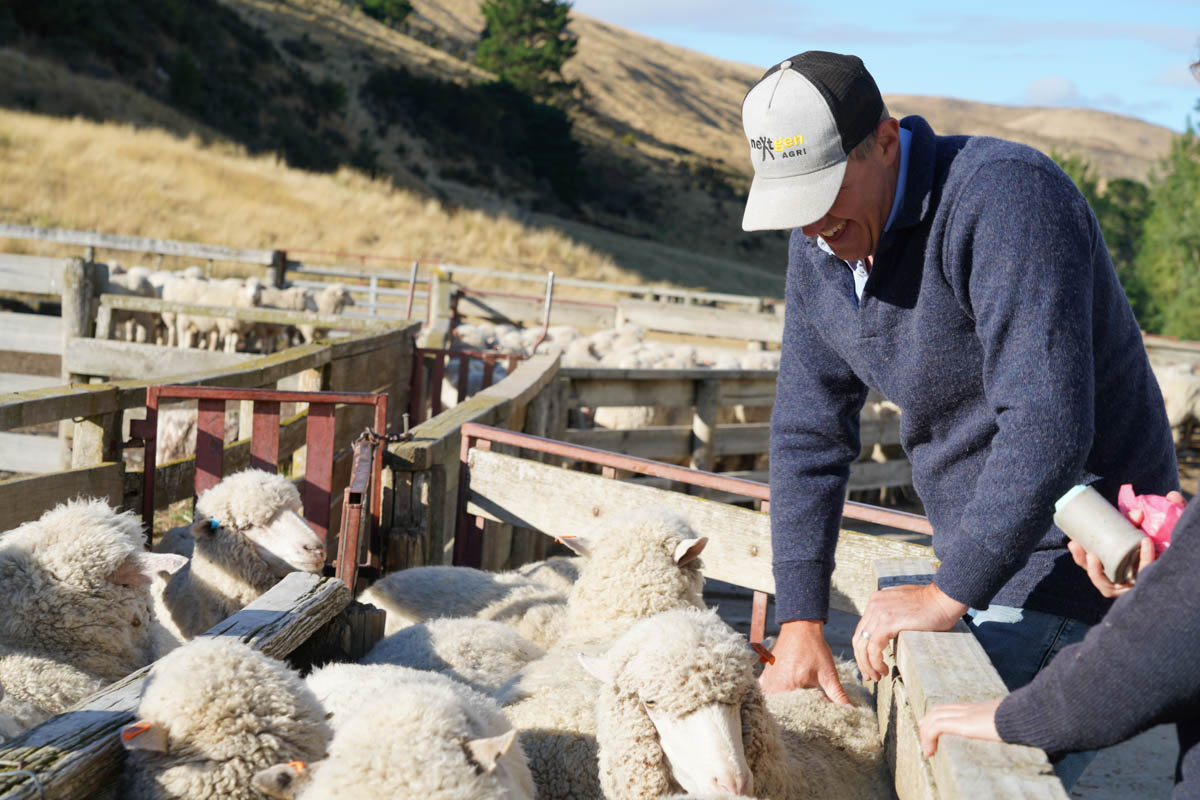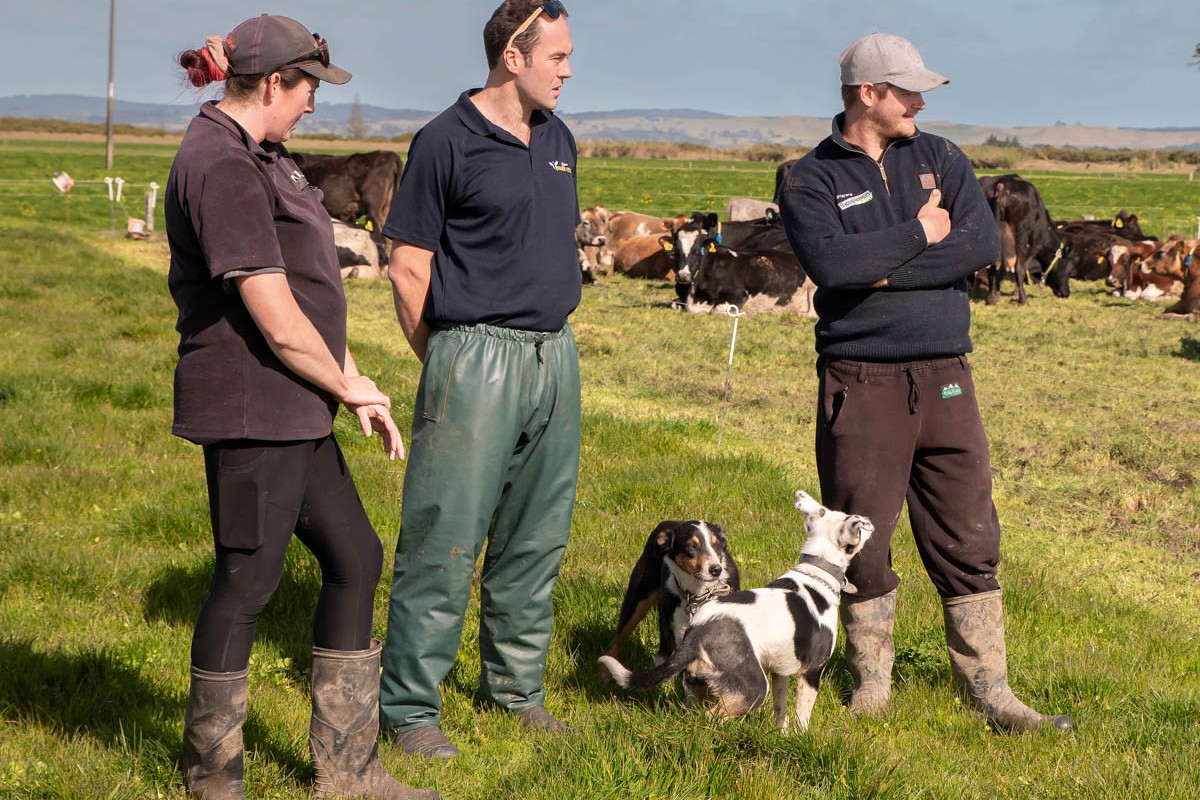The effects of major flooding brought a Manawatu woman back to her family farm. Russell Priest reports. Photos by Brad Hanson.
Running a farm with her dad as well as a household keeps a Manawatu farmer on her toes.
Kay Gallen (41) is managing a 468-hectare sheep and beef farm with her father Richard Adkins who has lived on the farm his entire life.
When a weather bomb hit the farm in 2004 Kay put her extramural accountancy studies on hold and helped her father.
The farm runs 1430 A flock and 420 B flock ewes. The B mob includes the fiveyear ewes and any not considered visually good enough for breeding replacements.
Rams go out on March 23, after the ewes have been running with teasers for 19 days. Hildreth Romney rams service the B flock. Rams are out for two cycles at a ratio of 1: 60-70.
Kay is considering mating the latter earlier now that more flat land is available.
Scanning this year was the best ever (triplets are not scanned) at 172% with MA ewes at 182% and two-tooths at 162%. The last two years ewes docked 140%.
Kay says they would be happy with consistently docking 140 – 145%.
“It’s all very well having lots of lambs but you’ve got to feed them.”
Ewes are wintered in their own agegroup rotations with the B ewes run separately on a different block.
Romney ram selection is based on structural soundness, a sound fleece, fertility/fecundity, early growth to weaning and a good maternal index.
Kay is married to Tony Gallen (42), a stock agent for PGG Wrightson and they have two children, Hamish (7) and Ben (5).
She is the fourth generation of Adkins to farm 217ha Norbury since her great grandfather bought the farm in 1896. A long narrow 152ha adjoining piece of land known as Whiteheads was added in 1904, a 3.5ha Pakihikura township block in the mid-1990s and adjacent 95ha Topaki in 2007.
In 2007 her dad and mum, Liz (71), changed ownership structure from a partnership to a company, Norbury Farm, which allowed them to bring in Kay as a director.
Pakihikura is regarded as a difficult sheep farming environment with its steep terrain, shallow top soils, high summer temperatures/humidity contributing to its susceptibility to summer drought and fungal toxins.
Despite using top sheep genetics, lambing percentages have been slow to respond.
They believe however they may have found a solution which can create a few management headaches but seems to be working for them.
All ewes are managed in age groups throughout their entire lives. “Ewes seem to hold their condition much better possibly because of the reduced competition and we no longer have a tail end.”
And it’s not as if they have it all their own way – they still do some cleaning up after the lambs in the summer but Kay keeps a close eye on their condition.
Bionic capsules have been used in the ewe flock for the last two years and these may have contributed to the increased performance.
Kay says lambs were finished earlier and at better weights. That allowed the second-cut ewe lambs on the rape which brought them up to a similar weight as the first cut.
Most cultivable land is cropped. This year about 29ha of summer and winter crops will be grown which include Hunter brassica, rape, chicory/clover, kale, triticale or an annual ryegrass.
Summer crops are rotationally fed to finishing lambs by subdividing paddocks with temporary electric fences.
After grazing with lambs, rape regrowth is used as winter feed for heifers. Kale and triticale are grown to winter cattle.
Chicory/clover growth is checked in the autumn using 0.5 litres/ha Roundup and undersown with Ohau ryegrass to provide winter grazing.
This year an area of raphnobrassica is being trialled.
Kay says they’ve only had to dag a few animals before shearing since using the capsules.
“The ewes have looked amazing, particularly the two-tooths who often used to look a bit hard.”
She says once they’re in good condition at weaning it’s much easier to keep them there. The two-tooths in particular have a lot more twins as four-tooths.
“We’ve produced the best lambs ever these last two years and last year averaged $133.”
One of Richard’s wishes is that neither ewe hoggets nor 15-month heifers are mated. Besides the likelihood of having to reduce stock numbers, the inaccessibility of the Whitehead block lends itself to wintering ewe hoggets and some two-year heifers.
They winter 500 ewe hoggets on 40ha out the back after giving them a long-acting drench and don’t see them again until late October/early November when they’re shorn.
“This gives us time to get the docking out of the way up front so we can box mobs together allowing us to bring the hoggets forward.”
They employ Sarah Lilburn (32) as a casual worker who Kay says is an invaluable team member. Tony is a busy stock agent, but helps out on the farm and with family duties when he can.
Norbury is divided into 62 paddocks and rises from 290 metres to 460m at the house. It has a long, narrow piece of hill country known as Whiteheads’ which doesn’t suit a laneway and the back boundary is 7km from the homestead. This creates major management problems and limits grazing by certain stock classes during periods of the year.
Calving hands-on
Kay and her dad Richard both love working with cattle which have good temperament.
The business used to buy in replacement females and mate them to Charolais bulls however most of them were culls. So they decided to breed their own replacements and haven’t looked back. For the last two years the weaner steers have averaged $1160 and the cull weaner heifers $833.
Norbury runs 150 mainly Angus cows including 30-35 R3 heifers. They clean up roughage and produce a valuable product in the form of a saleable weaner as well as quality replacements. Cows are put to work after weaning, spread out over much of the farm during the winter.
Calving begins in lambing paddocks at the front of the farm on September 1 with the three-year heifers followed by the MA cows two weeks later. Quality home-grown hay is fed out daily with cows being inspected at least twice a day. Recording of the calf’s sex and its mother’s number occurs soon after birth. When calves are mobile enough cow and calf are moved on to saved pasture nearby. From this time until weaning cows and calves are not run with sheep.
“We are probably more hands on at calving than most farmers.”
In the past if a cow lost a calf which hasn’t occurred very often, they would have fostered a calf on but Mycoplasma bovis has put a stop to that.
“We’re keeping the herd as closed as possible from now on.”
Kay has always carried a notebook around with her recording the numbers of cows displaying faults like poor temperament, bad feet and any rearing poor calves.
Bulls go to heifers in mid-November and cows on December 1 at a ratio of 1:30 and rotated around mobs after a cycle. Mating is for two cycles only with a dry rate of 6-8% being normal.
Bull selection is based on temperament, soundness, eye appeal, good 200, 400 and 600-day weight EBVs and the self-replacing index.
In February the calves are drenched and the cows divided into two mobs based on their calf’s sex. This simplifies the weaning process when cows and sale calves are mustered in on sale-day morning, separated and trucked to the sale.
Yard-weaning of the heifer calves occurs two weeks earlier with the culls being put back with their mothers and separated on sale day. Cows rearing steer calves are generally fed better than those rearing heifer calves.
Cropping benefit
Kay says the farm’s fertiliser requirements in recent years have not been fully addressed due to financial constraints. An extensive soil test is well overdue.
“The fertility on the flats is a lot better than on the hills ’cos they’re easier to apply fertiliser to using our little bike-towed spreader.”
Buying the easy-contoured Topaki and extensive drainage has enabled the business to do a lot more cropping and pasture renewal.
“Last season was the first we haven’t sold a store cryptorchid lamb.”
About one third of the farm can be worked with a tractor, the rest is medium-to-steep hill country. Soils are mostly of sedimentary origin (compacted and uncompacted sand, some papa and clay) with a light mantle of ash. The soils respond well to both sulphur and phosphate.
KEY POINTS
• A 476ha sheep and beef breeding and finishing farm.
• In Pakihikura Valley, 46km north of Feilding.
• Difficult sheep-farming environment.
• Sheep performance steadily improving.
• All home-grown lambs are now finished.
• Income/ha $1130 for 2017/18
• Farm working expenses/ha $488




